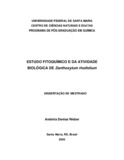| dc.creator | Weber, Andréia Denise | |
| dc.date.accessioned | 2017-05-11 | |
| dc.date.available | 2017-05-11 | |
| dc.date.issued | 2005-08-12 | |
| dc.identifier.citation | WEBER, Andréia Denise. Study phytochemical and of the activity biological
of Zanthoxylum rhoifolium. 2005. 138 f. Dissertação (Mestrado em Química) - Universidade Federal de Santa Maria, Santa Maria, 2005. | por |
| dc.identifier.uri | http://repositorio.ufsm.br/handle/1/10595 | |
| dc.description.abstract | Four previously known dihydrobenzophenanthridine alkaloids,
Dihydrochelerythrine (39), Bocconoline (42), Chelerythrine (2) and 6- Acetonyldihydrochelerythrine (33), were isolated from the stem bark of Zanthoxylum rhoifolium, along with other three lignans and the triterpen Lupeol (11). One of the lignans was identified as being sesamine (114), common in
Zanthoxylum and the other two, already known, called Kaerophyllin (117) and Gadain (120) belong to dibenzylbutyrolactones. However, Kaerophyllin (117) and
Gadain (120) were isolated for the first time from the Zanthoxylum rhoifolium. The structures of these metabolites were determined, mainly through spectroscopic methods, such as Nuclear Magnetic Resonance Spectroscopy 1H e 13 C (COSY, HMQC e HMBC), mass spectrometry and through the comparison of the data obtained from the melting point and data from the literature. The pure compounds and the hexane and eterea acid fractions, as well as chloroform basic fraction were tested for antitumor activity with nine cultured human tumor cell lines in vitro: MCF-7 (breast), NCI-ADR (breast with phenotype of the drug-resistant), UACC-62 (melanoma), NCI-460 (lung), PCO-3 (prostate), HT29 (colon), OVCAR (ovary), 786-0 (kidney) e K-562 (leukemia). The dihydrobenzophenanthridine alkaloids and the fractions showed more active, inhibiting the growth and provoking the death of several cell lines. On the other hand, the lignans showed no significant activity, being that, gadain (120) showed citostatic activity for all lines, only in the largest concentration tested. Through antimicrobial activity assays against Gram-positive bacteria: Staphylococcus aureus, Staphylococcus epidermidis and Bacillus subtilius; ramnegatives: Klebsiella pneumoniae, Pseudomonas aeruginosa, Escherichia coli and Salmonella setubal and fungi: Candida albicans, Candida dubliniensis, Sacharomyces cerevisiae and Cryptococcus neoformans, it was possible to
observe that the alkaloids and the fractions were really active, mainly against bacteria. Chelerythrine (2) was the most active compound due to the growth inhibition of all the tested microorganisms, at the lowest concentration tested
(0.15μg). The lignans were inactive against the tested microorganisms. The results found through the Microdilution Method showed that the alkaloid Chelerythrine presents a fungicide bacteriostatic property. | eng |
| dc.format | application/pdf | por |
| dc.language | por | por |
| dc.publisher | Universidade Federal de Santa Maria | por |
| dc.rights | Acesso Aberto | por |
| dc.subject | Zanthoxylum rhoifolium | por |
| dc.subject | Alcalóides | por |
| dc.subject | Lignanas | por |
| dc.subject | Atividade
antitumoral | por |
| dc.subject | Antimicrobiana | por |
| dc.subject | Zanthoxylum rhoifolium | eng |
| dc.subject | Alkaloids | eng |
| dc.subject | Lignans | eng |
| dc.subject | Antitumor | eng |
| dc.subject | Antimicrobial activity | eng |
| dc.title | Estudo fitoquímico e da atividade biológica de Zanthoxylum rhoifolium | por |
| dc.title.alternative | Study phytochemical and of the activity biological
of Zanthoxylum rhoifolium | eng |
| dc.type | Dissertação | por |
| dc.description.resumo | Quatro alcalóides benzofenantridínicos já conhecidos, Diidrocheleritrina (39), Bocconolina (42), Cheleritrina (2) e 6-Acetonildiidrocheleritrina (33), foram isolados da casca da raiz de Zanthoxylum rhoifolium, juntamente com outras três
lignanas e o triterpeno Lupeol (11). Uma das lignanas foi identificada como sendo a Sesamina (114), comum no gênero Zanthoxylum e as outras duas pertencem à classe dibenzilbutirolactônica, denominadas de Kaerofilina (117) e Gadaina (120), ambas já conhecidas, porém foram isoladas pela primeira vez de Zanthoxylum rhoifolium. As estruturas destes metabólitos foram determinadas, principalmente, por métodos espectroscópicos, como a espectroscopia de Ressonância Magnética Nuclear 1H e 13 C (COSY, HMQC e HMBC), espectrometria de massas e através da comparação dos dados obtidos a partir do ponto de fusão e dados da literatura. Os compostos puros e as frações ácidas hexânica e etérea, bem como a fração clorofórmica básica foram submetidas a testes de atividade antitumoral com nove linhagens de culturas de células tumorais humanas in vitro: MCF-7 (mama), NCI-ADR (mama com fenótipo de resistência a múltiplas drogas), UACC-62 (melanoma), NCI-460 (pulmão), PCO-3 (próstata), HT-29 (cólon), OVCAR (ovário), 786-0 (rim) e K-562 (leucemia). Os alcalóides benzofenantridínicos e as frações apresentaram-se mais ativos, inibindo o crescimento e provocando a morte de diversas linhagens celulares. Já as lignanas apresentaram atividade pouco significativa, sendo que gadaina (120) exibiu atividade citostática para todas as
linhagens, somente na maior concentração testada. Através dos ensaios de atividade antimicrobiana contra bactérias Grampositivas: Staphylococcus aureus, Staphylococcus epidermidis e Bacillus subtilius; Gram-negativas: Klebsiella pneumoniae, Pseudomonas aeruginosa, Escherichia coli e Salmonella setubal e fungos: Candida albicans, Candida dubliniensis, Sacharomyces cerevisiae e Cryptococcus neoformans, observou-se que os alcalóides e as frações foram bastante ativos, principalmente, contra bactérias. Cheleritrina (2) foi o composto mais ativo, devido à inibição de rescimento de todos os microrganismos testados, na menor das concentrações testadas (0,15μg). As lignanas não foram ativas contra os microrganismos testados. Através dos resultados obtidos pelo Método de Microdiluição, observou-se que o alcalóide cheleritrina apresenta caráter bacteriostático e fungicida. | por |
| dc.contributor.advisor1 | Morel, Ademir Farias | |
| dc.contributor.advisor1Lattes | http://buscatextual.cnpq.br/buscatextual/visualizacv.do?id=K4783930A8 | por |
| dc.contributor.referee1 | Dalcol, Ionara Irion | |
| dc.contributor.referee1Lattes | http://buscatextual.cnpq.br/buscatextual/visualizacv.do?id=K4797864E9 | por |
| dc.contributor.referee2 | Hoelzel, Solange Cristina da Silva Martins | |
| dc.contributor.referee2Lattes | http://buscatextual.cnpq.br/buscatextual/visualizacv.do?id=K4782041U2 | por |
| dc.creator.Lattes | http://buscatextual.cnpq.br/buscatextual/visualizacv.do?id=K4705296H3 | por |
| dc.publisher.country | BR | por |
| dc.publisher.department | Química | por |
| dc.publisher.initials | UFSM | por |
| dc.publisher.program | Programa de Pós-Graduação em Química | por |
| dc.subject.cnpq | CNPQ::CIENCIAS EXATAS E DA TERRA::QUIMICA | por |


